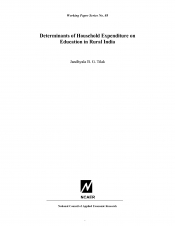Determinants of Household Expenditure on Education in Rural India
Jandhyala B. G. Tilak
August 2002
Using NCAER survey data on Human Development in rural India (HDI) (1994), supplemented by other sources, the paper examines the extent of household expenditure on education by different groups of population and the determinants of family expenditures on education. It also measures the elasticity of household expenditure on education to changes in household income on the one hand and government expenditure on education on the other. It has been found that there is nothing like 'free' education in India. Household expenditures on education are sizeable; households from even lower socio-economic background—Scheduled Castes/Tribes, low income groups—all spend considerable amounts on acquiring education, including specifically elementary education, which is expected to be provided free to all by the State. Important items of household expenditures consist of books, uniforms and fees. Even in the case of government primary and upper primary schools, students seem to be paying huge amounts of fees—examination and other fees. It is also found that households do not discriminate much against spending on girls' education; substantial differences exist in household expenditures between expenditure on children attending government schools, government-aided schools and private schools. Among the determinants of household expenditures, household characteristics—particularly household income and the educational level of the head of the household—are found to be important. Other important determinants include demographic burden of the household (size of the household), caste and religion. Generally, gender is believed to be a very significant determinant of household expenditures on education. This is not necessarily true in all cases. School related variables chosen—the incentives such as mid-day meals, uniforms, textbooks and stationery, etc., and the availability of school within the habitation—are also quite important. Coefficients of elasticity clearly show that government expenditures and household expenditures do not substitute each other, instead they complement each other. So if the government wishes to mobilise household finances for education, it is important that the government increase its own allocation to education considerably. Conversely, and more clearly, if government budgets on education are reduced, household expenditures may also decline resulting in severe under investment in education.
Human Development and Data Innovation







